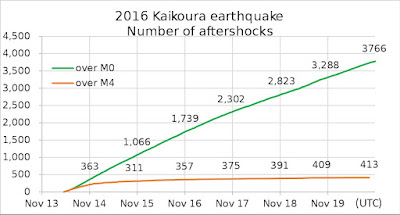Foreshocks and Aftershocks
Sometimes a large earthquake is preceded by smaller quakes. The smaller earthquakes are known as foreshocks. If a large number of the earthquakes occur is called an earthquake swarm.
On April 23, 2017, there was a report of a significant earthquake swarm off the coast of Chile near Valparaiso. The next day a magnitude 6.9 earthquake struck the same area.
Aftershocks are the earthquakes and tremors that occur after a larger earthquake. The magnitude of aftershock earthquakes can be as high as the original earthquake. Aftershocks can occur immediately after main quake, and continue occurring days, weeks, or months afterwards. Hundreds and even thousands of aftershocks can follow a significant earthquake, although only a small percentage will be large enough to cause significant additional damage.
It is not uncommon for aftershocks to end up causing more damage than the main earthquake as the main quake will significantly weaken structures, and the aftershocks may finish the job. It is because of this people are often advised to not enter damaged structures after an earthquake, until the building has been determined safe to enter.
On August 24 2016, a magnitude 6.2 earthquake struck near the town of Amatrice, Italy. It left 300 people dead, 2500 lost their homes, and 1800 aftershocks occurred in five days’ time.
Later that year, on October 30, a magnitude 6.6 earthquake struck the same region. It was preceded by a magnitude 5.5 earthquake on October 26.
Regarding these earthquakes in Italy, the damage that resulted was because they were not used to bigger earthquakes, and many of their buildings, particularly the older ones, were not built to the withstand earthquakes. Most of the damaged and destroyed buildings were constructed of unreinforced masonry.
Interestingly there were no deaths from the larger October quake. This was attributed to the warnings given as result of the foreshock that occurred a few days earlier, and many people were not in their homes and buildings at the time of the bigger earthquake.
As for how long aftershocks can follow, the longest I’ve heard of was in a recent article on KSL.com titled “Aftershocks from 1959 earthquake sent tremors through Yellowstone in 2018.”
The article references a study published in April 2019 title The 2017–2018 Maple Creek Earthquake Sequence in Yellowstone National Park, USA
The 1959 earthquake was a magnitude 7.3 known as the Hebgen Lake earthquake. In some places the ground dropped 20 feet, and 28 people died. The study identified more than 3000 quakes , localized in the Maple Creek area, that occurred from June 2017 to March 2018. Earthquake swarms are common in the Yellowstone area, and often result in numerous claims that a major disaster is about to strike, like a super volcano eruption.
The particular swarm referenced had more tremors and lasted longer than usual. The researchers divided the tremors into a couple of subgroups. They ruled out magma or other activity as causing the norther cluster of quakes. Formulas are used for predicting how many aftershocks should follow a quake, and they discovered the Hebgen Lake quake was short the number of aftershocks. When the norther cluster of quakes were factored in to the Hebgen Lake event, it evened out aftershock expectations to what would be expected.
As for the southern cluster of tremors during the identified time period, the researchers determined they were likely caused by magma moving.



Comments
Post a Comment